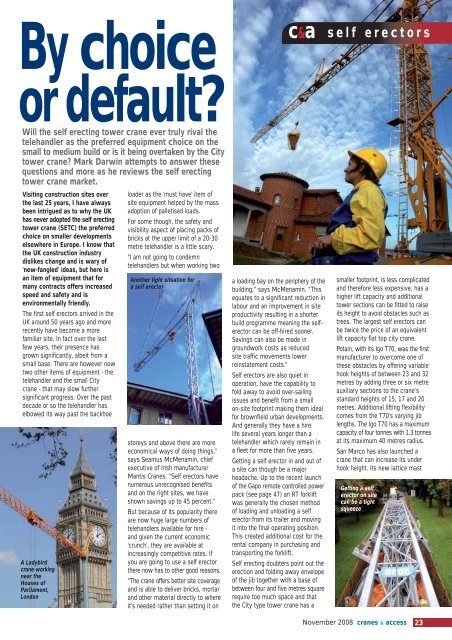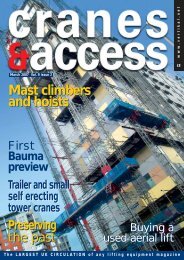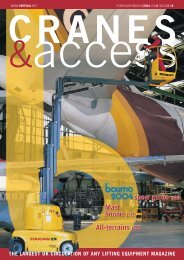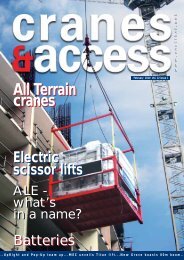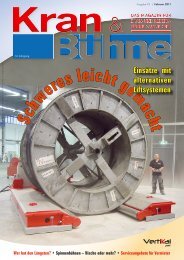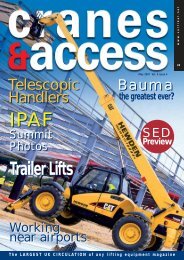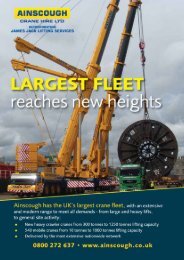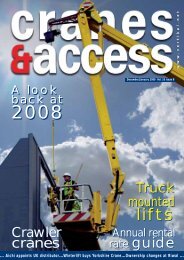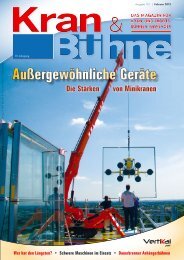Create successful ePaper yourself
Turn your PDF publications into a flip-book with our unique Google optimized e-Paper software.
By choice<br />
or default?<br />
Will the self erecting tower crane ever truly rival the<br />
telehandler as the preferred equipment choice on the<br />
small to medium build or is it being overtaken by the City<br />
tower crane? Mark Darwin attempts to answer these<br />
questions and more as he reviews the self erecting<br />
tower crane market.<br />
Visiting construction sites over<br />
the last 25 years, I have always<br />
been intrigued as to why the UK<br />
has never adopted the self erecting<br />
tower crane (SETC) the preferred<br />
choice on smaller developments<br />
elsewhere in Europe. I know that<br />
the UK construction industry<br />
dislikes change and is wary of<br />
'new-fangled' ideas, but here is<br />
an item of equipment that for<br />
many contracts offers increased<br />
speed and safety and is<br />
environmentally friendly.<br />
The first self erectors arrived in the<br />
UK around 50 years ago and more<br />
recently have become a more<br />
familiar site. In fact over the last<br />
few years, their presence has<br />
grown significantly, albeit from a<br />
small base. There are however now<br />
two other items of equipment - the<br />
telehandler and the small City<br />
crane - that may slow further<br />
significant progress. Over the past<br />
decade or so the telehandler has<br />
elbowed its way past the backhoe<br />
A Ladybird<br />
crane working<br />
near the<br />
Houses of<br />
Parliament,<br />
London<br />
loader as the 'must have' item of<br />
site equipment helped by the mass<br />
adoption of palletised loads.<br />
For some though, the safety and<br />
visibility aspect of placing packs of<br />
bricks at the upper limit of a 20-30<br />
metre telehandler is a little scary.<br />
"I am not going to condemn<br />
telehandlers but when working two<br />
Another tight situation for<br />
a self erector<br />
storeys and above there are more<br />
economical ways of doing things,"<br />
says Seamus McMenamin, chief<br />
executive of Irish manufacturer<br />
Mantis Cranes. “Self erectors have<br />
numerous unrecognised benefits<br />
and on the right sites, we have<br />
shown savings up to 45 percent.”<br />
But because of its popularity there<br />
are now huge large numbers of<br />
telehandlers available for hire -<br />
and given the current economic<br />
'crunch', they are available at<br />
increasingly competitive rates. If<br />
you are going to use a self erector<br />
there now has to other good reasons.<br />
“The crane offers better site coverage<br />
and is able to deliver bricks, mortar<br />
and other material directly to where<br />
it's needed rather than setting it on<br />
c&a<br />
a loading bay on the periphery of the<br />
building,” says McMenamin. “This<br />
equates to a significant reduction in<br />
labour and an improvement in site<br />
productivity resulting in a shorter<br />
build programme meaning the selferector<br />
can be off-hired sooner.<br />
Savings can also be made in<br />
groundwork costs as reduced<br />
site traffic movements lower<br />
reinstatement costs."<br />
Self erectors are also quiet in<br />
operation, have the capability to<br />
fold away to avoid over-sailing<br />
issues and benefit from a small<br />
on-site footprint making them ideal<br />
for brownfield urban developments.<br />
And generally they have a hire<br />
life several years longer than a<br />
telehandler which rarely remain in<br />
a fleet for more than five years.<br />
Getting a self erector in and out of<br />
a site can though be a major<br />
headache. Up to the recent launch<br />
of the Gapo remote controlled power<br />
pack (see page 47) an RT forklift<br />
was generally the chosen method<br />
of loading and unloading a self<br />
erector from its trailer and moving<br />
it into the final operating position.<br />
This created additional cost for the<br />
rental company in purchasing and<br />
transporting the forklift.<br />
Self erecting doubters point out the<br />
erection and folding away envelope<br />
of the jib together with a base of<br />
between four and five metres square<br />
require too much space and that<br />
the City type tower crane has a<br />
self erectors<br />
smaller footprint, is less complicated<br />
and therefore less expensive, has a<br />
higher lift capacity and additional<br />
tower sections can be fitted to raise<br />
its height to avoid obstacles such as<br />
trees. The largest self erectors can<br />
be twice the price of an equivalent<br />
lift capacity flat top city crane.<br />
Potain, with its Igo T70, was the first<br />
manufacturer to overcome one of<br />
these obstacles by offering variable<br />
hook heights of between 23 and 32<br />
metres by adding three or six metre<br />
auxiliary sections to the crane’s<br />
standard heights of 15, 17 and 20<br />
metres. Additional lifting flexibility<br />
comes from the T70's varying jib<br />
lengths. The Igo T70 has a maximum<br />
capacity of four tonnes with 1.3 tonnes<br />
at its maximum 40 metres radius.<br />
San Marco has also launched a<br />
crane that can increase its under<br />
hook height. Its new lattice mast<br />
Getting a self<br />
erector on site<br />
can be a tight<br />
squeeze<br />
November 2008 cranes & access<br />
23


